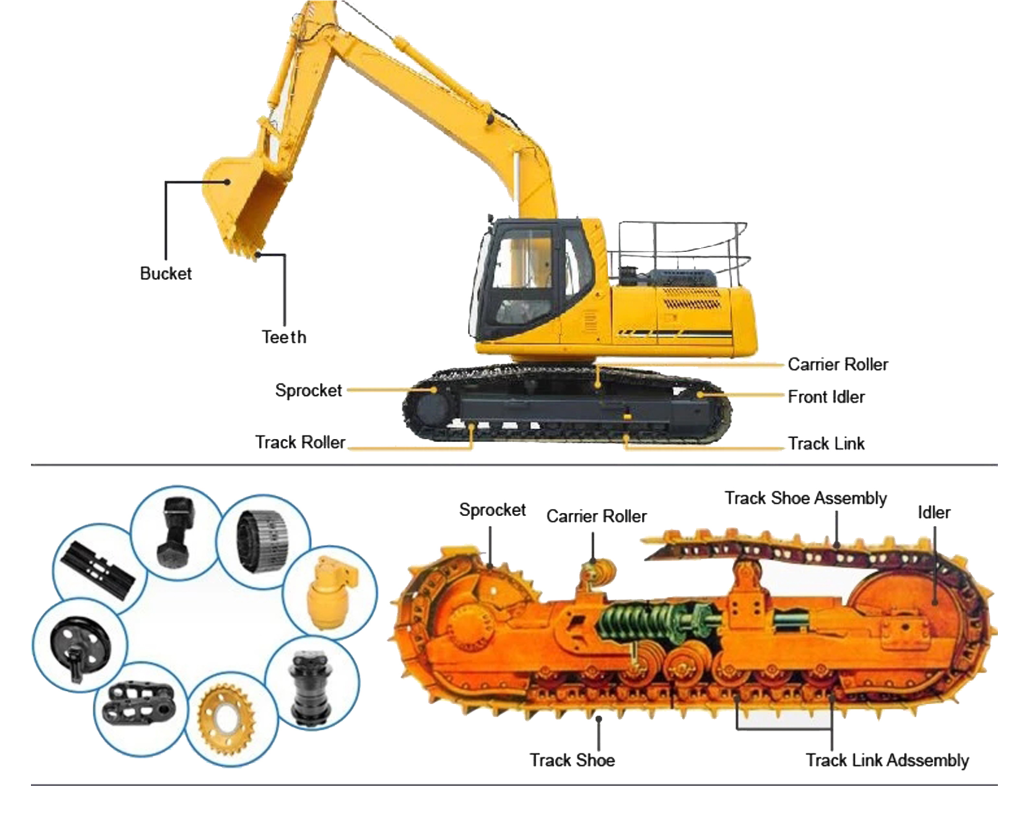Excavators are essential heavy machinery used in construction, mining, and earthmoving projects. They are designed to perform a variety of tasks, including digging, lifting, and transporting materials. Understanding the main components of an excavator is crucial for operators and maintenance personnel alike. Here’s an introduction to the key parts of an excavator:
parts of excavator and their functions:

Key Parts of an Excavator
1. Cab
- Description: The enclosed space where the operator sits.
- Function: Contains controls, gauges, and safety features. Provides visibility and comfort for the operator during work.
2. Boom
- Description: The long arm extending from the excavator’s body.
- Function: Provides reach and height for performing digging and lifting tasks, critical for accessing materials at various depths.
3. Stick (or Arm)
- Description: The component connecting the boom to the bucket.
- Function: Allows for the extension and retraction of the bucket, enabling precise movements for digging and material handling.
4. Bucket
- Description: The attachment at the end of the stick.
- Function: Used for scooping, digging, and lifting materials. Different bucket designs are available for specific tasks, such as grading or trenching.
5. Tracks (or Wheels)
- Description: The undercarriage components that provide mobility.
- Function: Tracks are typically used for stability on uneven surfaces, while wheeled excavators are designed for faster travel on solid ground.
6. Engine
- Description: The power source of the excavator.
- Function: Powers the hydraulic system and provides energy for all operational functions, including movement and attachment activities.
7. Hydraulic System
- Description: A system of pumps, valves, and cylinders.
- Function: Uses hydraulic fluid to power the movement of the boom, stick, and bucket, allowing for smooth operations and control.
8. Counterweight
- Description: A heavy structure located at the rear of the excavator.
- Function: Balances the machine to prevent tipping during heavy lifting and digging operations.

9. Swing Mechanism
- Description: The system that allows the upper body of the excavator to rotate.
- Function: Enables the cab, boom, and stick to swing 360 degrees, allowing the operator to reposition without moving the entire machine.
10. Chassis
- Description: The main structural framework of the excavator.
- Function: Supports the engine, hydraulic system, and other components, providing overall stability and integrity to the machine.
Summary Table of Excavator Parts
| Part | Description | Function |
|---|---|---|
| Cab | Operator’s compartment | Houses controls and provides visibility and comfort |
| Boom | Long arm extending from the body | Provides reach and height for digging and lifting |
| Stick (Arm) | Connects boom to the bucket | Controls bucket movement for precise digging |
| Bucket | Attachment at the end of the stick | Used for digging, scooping, and lifting materials |
| Tracks/Wheels | Undercarriage components | Provides mobility and stability on various terrains |
| Engine | Power source of the excavator | Drives hydraulic systems and powers machine operations |
| Hydraulic System | Network of pumps and valves | Powers movements of boom, stick, and bucket |
| Counterweight | Heavy block at the rear | Stabilizes the machine during operation |
| Swing Mechanism | Allows upper structure to rotate | Enables 360-degree rotation for repositioning |
| Chassis | Main structural frame | Supports engine and components, providing integrity |
Conclusion
Understanding the parts of an excavator is fundamental for effective operation and maintenance. Each component plays a vital role in the machine’s overall functionality, enabling it to perform a wide range of tasks efficiently. If you have any questions or need more information about specific parts, feel free to ask!